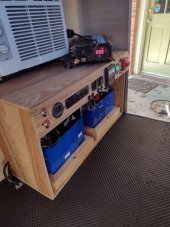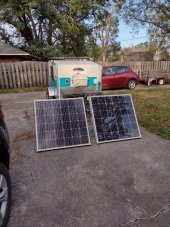Here's my first attempt at designing my system. It's for a very cute 4'x8' camper called a Runaway. I bought (4) 280Ah LiFePO4 mystery cells on Aliexpress and thought they were defective (I was defective). Meanwhile, ordered (4) more 280Ah from Amy at Shenzhen Luyuan which are boating their way here. So now I have double the capacity I originally planned for. Since I assume they are of differing quality (e.g. internal resistance, age, etc), I am planning to run (2) independent packs, each with a BMS, with a switch. I would like to wire it so that I could have one pack charging while the other pack is used for loads but this is above my head. I'm open to suggestions about that if it doesn't make the setup too much more complicated.
I have the 120A Overkill BMS but thinking I might switch to the 150A BMS sold by Current Connected for the 2nd BMS. I see the owner posts here.
I've been trying to learn for a good while. I am open to any feedback that can make my system safer and more efficient / effective.
Wiring:
Batteries to Switch: 2/0 AWG
Switch to Busbar: 2/0 AWG
Busbar to Inverter: 2/0 AWG
Busbar to Charge Controller: 6 AWG
Controller to PV: 10AWG "Solar Panel Wiring"
Busbar to DC Fuse Block: 6 AWG
Thank you,
Carlo
I have the 120A Overkill BMS but thinking I might switch to the 150A BMS sold by Current Connected for the 2nd BMS. I see the owner posts here.
I've been trying to learn for a good while. I am open to any feedback that can make my system safer and more efficient / effective.
Wiring:
Batteries to Switch: 2/0 AWG
Switch to Busbar: 2/0 AWG
Busbar to Inverter: 2/0 AWG
Busbar to Charge Controller: 6 AWG
Controller to PV: 10AWG "Solar Panel Wiring"
Busbar to DC Fuse Block: 6 AWG
Thank you,
Carlo






